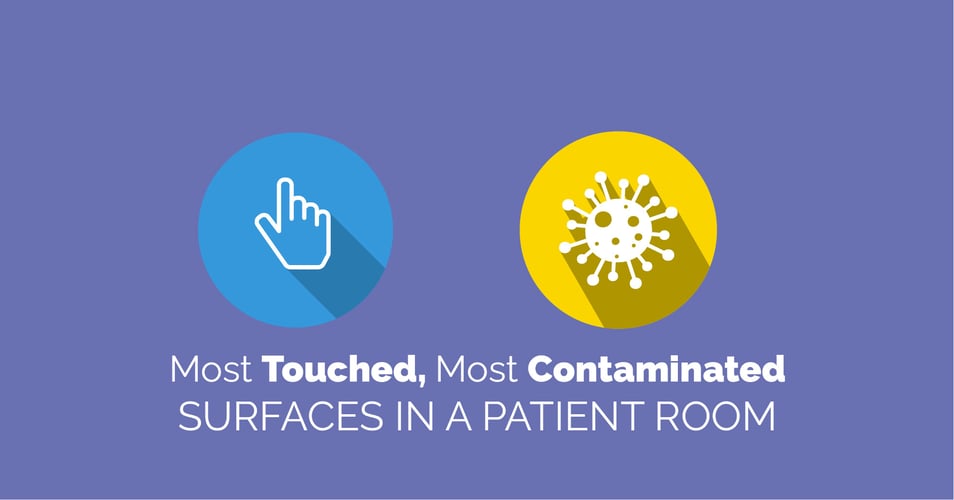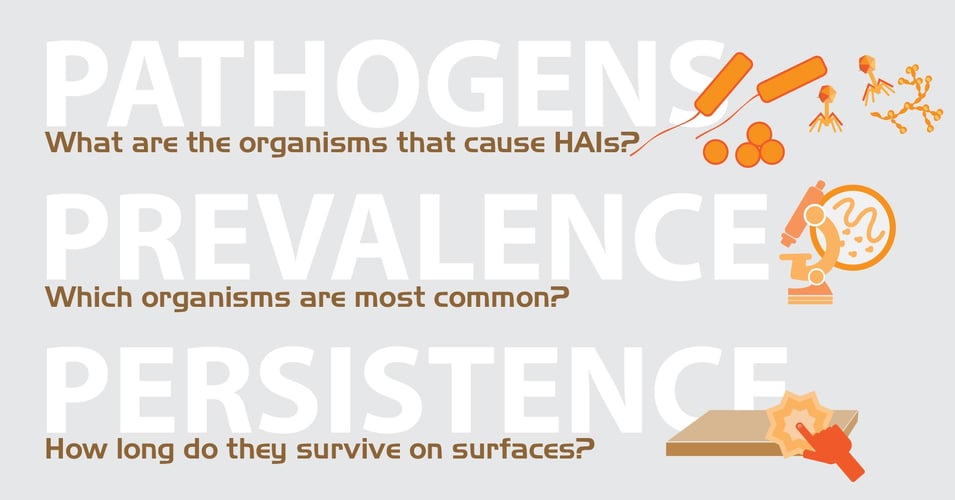Editor's Note: This post was originally published in February 2016 and has been updated for freshness, accuracy and comprehensiveness.
Cleaning House, Part 4: Touch Points

Erica Mitchell
4
min. read
Cleaning House, Part 4: Touch Points
7:02
In this series of posts on how to clean your house, we’ve covered some important lessons from the cleanest hospitals: Know your pathogen, pick the right cleaner, and level of disinfection. Today we will focus on the where and what of household cleaning, what hospitals call “touch points.”
Numerous studies have supported the idea that germs – disease-causing microorganisms – are transmitted not only person to person, but also from person to object to person. This object that serves as the intermediary can be a light switch, a door knob, a pen, or an article of clothing. We know that germs can survive long enough outside the body to be left on a surface by a contaminated individual and picked up by a healthy individual.
Contaminated host → Object → Susceptible person
There are things we can do to stop our contaminated hosts – our sick family member – from contaminating objects (handwashing, sneezing into a tissue, etc.) But what we are going to talk about today are the ways you can prevent the contaminated objects from spreading the sickness to the next person.
Touch Points
We touch over 300 surfaces every 30 minutes. Think about just the first 30 minutes after you get home from work or an errand. You touch the doorknob, keys, mailbox, mail, cabinet, closet doorknob, kitchen chair, fridge door, and on and on. On an everyday basis, these surfaces collect their share of microorganisms that usually don’t make us sick. When all those surfaces are touched by someone with the flu, however, they become a possible source of infection of people who touch that same surface later.
In a hospital, touch points are the subject of scientific research. Many studies have involved watching healthcare workers and noting what surfaces they touch most often, as well as which surfaces tend to harbor the most germs. With this information, hospitals can create cleaning protocols to help reduce the chance of spreading germs.
You can use the same technique at home, but you don’t have to do a research study first! What you want to do is focus on the most commonly touched surfaces in each room, as well as surfaces that provide a good place for germs to grow.
And to protect yourself: Wear gloves. Some basic dishwashing gloves will protect you from the harsh chemicals as well as from transferring germs to your face (which, without even noticing, we touch more than three times an hour).
Most Often Touched
Each room in your home will have its own touch points, but here are some to get you started. You can also print out the infographic at the end of this post to use as a checklist.
All rooms | Light switches, door handles, drawer pulls, closet door knobs, blind pulls
Living/Family Rooms | Remote, coffee table, phone, exercise equipment, gaming systems/controllers, toys, markers
Dining Room | Table edges, chair rails/arm rests
Kitchen | Fridge handles, contents of fridge that get used more than once (milk jug handle, for example), counter tops and under edges, appliances/appliance buttons (microwave, dishwasher, etc.), faucet handles, stove controls
Bathroom | Faucet handles, toilet flusher, toilet brush handle, towel rack, toothpaste, soap dispenser, face cream, shaving equipment, medicine bottles, toilet paper dispenser
Bedroom | Nightstand, lamp switches, remotes, phone chargers, hairbrush, headboard, waste bin, books and magazines, tablets, wallet tray, hangers
Vehicles | Steering wheel, seat belt buckle, gear shift, glove box handle, door handles (inside and out), sun visor, audio controls, car seats and buckles, light/door buttons
Surfaces Where Germs Grow
The most intensive cleaning will be in the bathroom. Bathrooms are often hot and humid, they have a regular supply of water that can sit in drains, undisturbed, for a long time. It is also where we will often dispose of used tissues, use a nasal treatment such as a spray or netty-pot, and of course, where the toilet is. Bathrooms also have soap, which is a ready source of nutrients to many microorganisms. So use a disinfectant to clean the floors, walls, cabinets, sink, faucets, and toilet – every conceivable surface. You should throw out toothbrushes and other oral care items (flossers, disposable water jet nozzles, etc.). A hospital trick for trashcans: Always line them with a plastic bag. When the trashcan is full, tie the bag shut while the bag is still in the trashcan, then lift it out to throw away. Never dump trash out into another bag or lift the open bag out of the trashcan – this amount of movement can release germs into the environment (aerosolizing germs).
In general, surfaces that are hard and smooth will support viruses longer than soft surfaces, such as linens. This means that you will want to disinfect kitchen and bathroom counters, toilets, tables, nightstands, and other hard surfaces in your home after an illness. Dishes, cups, and utensils should be washed on the hottest setting in your dishwasher. Washing dishes by hand prevents you from using water hot enough to kill germs, so if a dishwasher is not available, use a liquid disinfectant – but be sure to rinse each item in clear water before using it for food.
You can use spray disinfectant for soft surfaces like sofas, throw pillows, blankets, and shower curtains. Be sure to follow the instructions on your disinfectant to get the most disinfecting power.
For clothing worn by the person who was ill, as well as for their bed linens and towels, use the hottest setting on your washer as well as your dryer. If the clothing cannot support this heat, have the item dry cleaned. If possible, assign a specific hand towel to the individual who is ill, or use paper towels.
Finally, air out your home, not only to make sure to give your cleaning efforts good ventilation, but also to expose fragile viruses to air, which will speed their demise.
As a extra note, to help prevent future illness, learn and share these three points:
- Cough and sneeze into a tissue, or if all else fails, your elbow (not your hands!).
- Wash hands after coughing, sneezing, or caring for someone who is sick.
- Keep fingers and hands away from your own eyes, nose and mouth (rubbing eyes, wiping nose, etc) and avoid touching your face without first washing your hands.
These three things help reduce the amount of pathogens in the environment, what hospitals call the bioburden, and reduce the chance of transmission by limiting the chances that any germs your hands do pick up end up on a mucous membrane where they can enter the body (eyes, nose, mouth).
All this cleaning may seem like a lot of work (and it can be), but isn’t it worth it to keep the flu from knocking down the whole family? For a one-page summary of this series, please download the infographic below. We hope you and your loved ones stay well!


![[infographic] Cleaning House after Illness Download and share!](https://no-cache.hubspot.com/cta/default/216314/interactive-178385898605.png)



